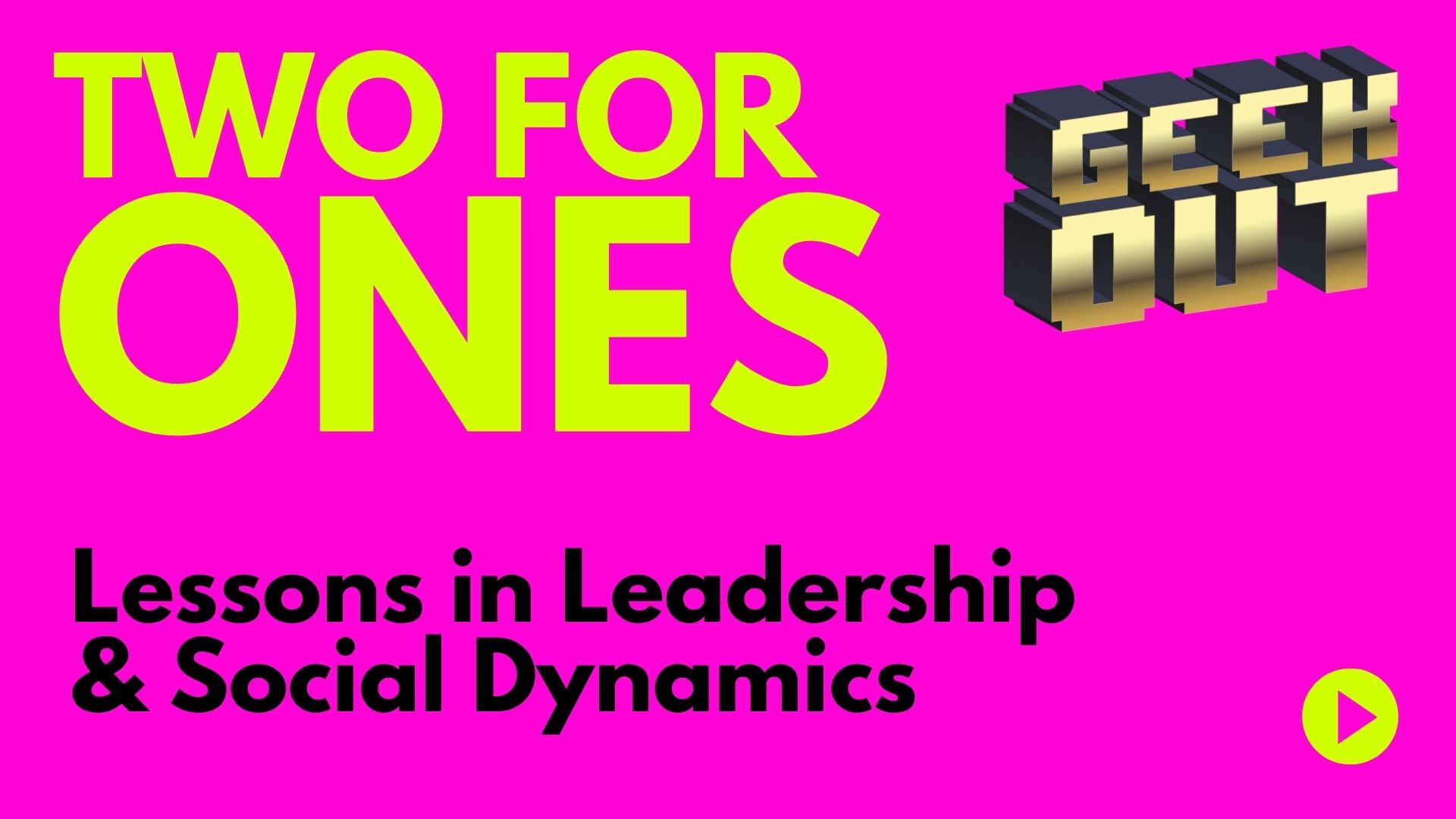
Two For Ones (Part One): Lessons in Leadership & Social Dynamics


I love two-for-ones. Two-for-ones, in business and anything else, are things that get you two outputs or outcomes for one input or value. In chess, for example, some of the most effective and devastating moves are both offensive and defensive.
My grandfather, “Pop-Pop Marvin,” was an incredible example of how seeking out two-for-ones can be transformational. The son of an immigrant, he dropped out of school in the seventh grade and started a flower shop. That grew to a seven-florist franchise by the time he was 18.
He always had a very giving heart, and he decided to use the money from his franchise to start a nursing home. This was a two-for-one in that it allowed him to make money (which he loved to do) and to help people (which he also loved to do).
That first nursing home had just seven beds. By the time he died, he’d grown the organization to about 2,500 beds, as well as assisted living communities and lots of other ancillary businesses. He also became chairman of the board of banks, he started schools, churches, and charitable organizations.
As I grew up and saw all of this, I knew I wanted to be like that too.
Lessons From Pop-Pop Marvin
I told my grandpa I wanted to come work for him at his company Christmas party when I was 12 years old. I thought I’d get to wear a shirt and tie and work in the office like he did (with the secretaries who gave me candy) but he told me that wasn’t the case.
Pop-Pop Marvin pointed to a group of C-level people that I knew at the party and said, “Those aren’t the people that make my business.” Then he pointed to the rest of the employees and said, “Those are the people that make my business — and you’re going to go work with them.”
My first summer, the job included cleaning blueberry pie stains off of bibs and digging holes for plants. But I learned that the people who do the work, not the people at the top, are what makes a business function, and that’s a lesson I never forgot.
Years later, I was sitting with him in his own nursing home near the end, and a long line of people came in to thank him for all that he had done for them. And the things they said ranged from paying to put their kids through school to covering a shift to see another kid graduate.
I learned that if you take care of your people, they will take care of you. And that has to do with a lot more than money. In fact, it requires finding a currency that’s more valuable than money.
My grandfather knew how to lead people, and he understood the relationships and value exchanges between employers and employees. Most importantly, he knew how to unlock potential and give opportunities to people to get them to perform. And finally, two-for-ones.
When something gives me two outputs for one input, I know that’s where I want to go.
Leadership Two For Ones & Lessons in Labor Management
I’ve had a lot of businesses in my life, but my call center business had a significant impact on how I do things today because that was all about labor management.
There was a lot of stuff we did in call centers then that probably wouldn’t even be legal today. One of the things we did was called “seat pressure”. We were always short one or two seats, so if you weren’t on time for your shift, you wouldn’t have a seat.
That was a lesson in motivation because people knew that they had to show up on time to get a good location.
We were also interviewing new people constantly, and we brought them in publicly to show the existing teams that the spots they had were highly sought after — and that if they couldn’t do the job, someone else would.
Rewarding the Process & Improving Through Self-Evaluation
Another lesson from the call center was that self-evaluation creates improvement. We had the people in the call center listen to their own recordings. That way, they heard themselves make pitches and corrected their own shortcomings.
We also learned to reward the process over the product. When you’re managing people, it’s easy to create an incentive by saying “If you produce X, I will pay you Y.” Often, however, that’s incorrect.
It’s better to say, “Here’s the goal. What do you need to do at work every day to reach it?” And then you reward the daily progress. Learning how to incentivize people without money is crucial.
Also, even though no one likes to fire people, sometimes letting someone go is a necessity for the good of the organization. If you want to run a successful business and surround your “A” players with other “A” players, firing people is something you’ll just have to do.
The last lesson I learned from my call center business is that going out of business sucks. And that laying off a bunch of people because of your own mistakes sucks too.
Lessons in Scaling and Hiring Foreign Labor
After that, I became an affiliate — being a one-man band with no employees seemed like the right decision. The call center had more than 400 employees, and I didn’t want to need that many humans to make money.
But the lesson I learned quickly in that role is that it’s very difficult to scale all by yourself. And then I found out about Upwork. And I found out about the value arbitrage of foreign labor. I can’t say enough about how important these people are — they’re so smart, and so hungry, and so cost-effective. There’s a value difference there.
The Importance of Clear & Effective Communication
I also learned about managing remote teams, which I still do. Some remote workers who joined my affiliate team 10 years ago are still working with me today. And when you have remote teams, you find out that clear, effective communication isn’t just important — it’s a sign of respect. Learning to communicate in detail with your people shows them that you value their time.
After my one-man affiliate period, I opened an office in Tel Aviv, Israel, which is the epicenter of media buying. It’s common to be involved in media buying and campaign management there.
An interesting thing about Israel is that everyone — men and women — have to be in the military. And it’s very easy to see if someone will be a good fit when you look at their resume and see what their role was in the military.
When candidates had experience in intelligence, or counter-intelligence, or defusing ordinance, you knew that they could handle pressure well. Someone who was a front-line grunt, however, might not be as good of a fit as a media buyer.
Two For Ones: Hiring For an Opportunity
The second thing I learned in Israel was about hiring for an opportunity. After some time, we started interviewing and hiring candidates who didn’t speak Hebrew. We found Russian and European immigrants who were experts in their fields but couldn’t find high-paying jobs because they didn’t know the language yet.
We went to the state-funded Hebrew language school and talked to the teachers to find the best candidates — and it worked! We found one candidate and taught her media buying from scratch, and now she’s been one of my partners for six years and counting.
I also learned about the importance of upward mobility within the company. Israelis are always focused on moving up, and if you can harness that as a motivating factor it can really help your business.
We also have two offices in Ukraine that have been very successful, and I’ve learned a lot from them. Two things stand out in particular.
Learning the Language (of Your Company)
The first thing we learned was about teaching employees the language of our company. We were already paying for overseas employees’ English lessons, but we started having the tutors watch their Zoom calls to see what they needed to learn to discuss topics specific to the business.
An amazing outgrowth of that was when employees in different departments on these group Zoom calls started forming their own communities and actually solving problems across departments for their colleagues. They became part of something and were working together to solve bigger problems.
Also, I learned to let go of details at the operational level that didn’t work for me but made my teams more effective.
This happened when I realized that my teams were communicating within ClickUp, our project management tool, in Russian. I couldn’t read what they were saying, which was frustrating at first. But I realized that I didn’t have to know what they were saying for them to produce great results. And that mindset shift was essential to reducing friction and further optimizing our teams.
Labor Optimization as an Organizational Need
Next, we launched a charity school a couple of years ago. We found people who had been overlooked in life, taught them how to be media buyers, and got them jobs. The two biggest lessons from this endeavor were:
- Empty minds are the easiest to fill.
- Helping people deal with a lack of self-esteem and/or self-reliance can unlock unbelievable potential.
Another underappreciated lesson is that labor optimization is an organizational need. There’s a saying in business and in sports — “we were doing so well that we stopped doing it.” A lot of teams start out focused, engaged, and committed, but when they succeed, they lose sight of how they got to that point.
Basketball teams that win championships, for example, don’t bring back the exact same roster year after year. They make trades and change out weak players for better fits to stay on top. Businesses can — and should — be like that too.
I learned another lesson about labor optimization from a friend who scaled his solar business from 50 to 1,500 employees in two years — “the team with the best players wins.” It sounds like another sports cliche, but it’s true.
Stay tuned for parts two and three of the “Two-For-Ones” series — coming soon!
Looking for more authentic marketing and leadership lessons from industry experts and entrepreneurs? Check out James' P3 Scaling System to grow your business, or click here to sign up for the next Geek Out event!



